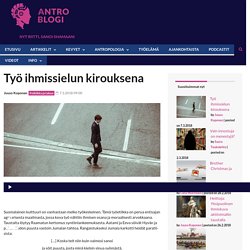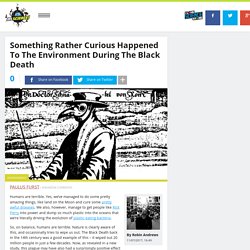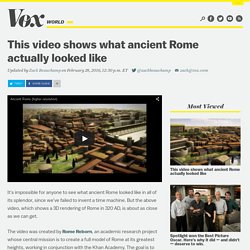

Tuore tutkimus kumoaa käsityksen siitä, että naiset muinoin keräilivät ja miehet metsästivät – suurriistaa jahtasivat molemmat - Tiede. Earliest Forms to Modern Latin Script. Joona-Hermanni Mäkisen kolumni: Maailmanlopun kello näyttää kaksi minuuttia vaille keskiyön. Työ ihmissielun kirouksena — AntroBlogi. Kapitalistisessa yhteiskunnassa vallitsevien ideologisten tajuntamuotojen ansiosta työelämän ulkopuolella oleminen on useimpien mielestä hyväksyttävää, mikäli sen tekee ”omilla rahoillaan”. ”Ideologisen työttömän” toiminta herättää suuttumusta, mutta aikakauslehdet nostavat ihailevaan sävyyn esille tarinoita downshiftauksesta tai oravanpyörän ulkopuolelle hyppäämisestä.

Time-lapse history of human global CO2 emissions. Here's what fruits and vegetables looked like before we domesticated them. Next time you bite into a slice of watermelon or a cob of corn, consider this: these familiar fruits and veggies didn't always look and taste this way.

Genetically modified foods, or GMOs, inspire strong reactions nowadays, but humans have been tweaking the genetics of our favourite produce for millennia. While GMOs may involve splicing genes from other organisms (such as bacteria) to give plants desired traits – like resistance to pests, selective breeding is a slower process whereby farmers select and grow crops with those traits over time.
From bananas to eggplant, here are some of the foods that looked totally different before humans first started growing them for food. How Fruit And Vegetables Have Changed Over Human History. If someone handed you a wild banana from 7,000 years ago, you would barely recognize it from its modern-day ancestor.

Fruit and vegetables have changed a lot since humans have domesticated them over the past few thousand years. They’ve undergone a transformation from selective breeding that has tailored them to suit our picky tastes and conveniences. More recently, fruit and veg have been molded by genetic engineering, allowing us to pick ‘n’ mix the best genes from desirable plants. An Interactive Experience - World Population. Teollinen vallankumous muutti perhosen mustaksi – ilmansaasteiden väheneminen vaalensi sen uudelleen. Old jobs. Vermont ditches Columbus Day for Indigenous Peoples' Day, Hartford may make the switch for good. HARTFORD, Vt. — Vermont has officially changed Columbus Day to Indigenous Peoples' Day.

Natives of North America. Something Rather Curious Happened To The Environment During The Black Death. Humans are terrible.

Yes, we’ve managed to do some pretty amazing things, like land on the Moon and cure some pretty awful diseases. We also, however, manage to get people like Rick Perry into power and dump so much plastic into the oceans that we’re literally driving the evolution of plastic-eating bacteria. So, on balance, humans are terrible. Nature is clearly aware of this, and occasionally tries to wipe us out. The Black Death back in the 14th century was a good example of this – it wiped out 20 million people in just a few decades. Writing in the journal GeoHealth, a team of researchers led by Harvard University have been tracking regional and global lead pollution over time, as revealed by a series of cutting-edge ice core analyses.
Lead is not a particularly nice thing to ingest or inhale. “During the Black Death pandemic, demographic and economic collapse interrupted metal production and atmospheric lead dropped to undetectable levels,” the team write in their study. Rome The ‘Eternal City’ In Its Peak Showcased Through A Brilliantly Animated Video. An incredible fruit of collaboration between the Rome Reborn project and Khan Academy, the video in question gives us a fascinating tour through the ancient mega city in its arguably peak form in 320 AD.

In essence, this was the period when emperor Constantine was successful in once again centralizing the power of the state, while also endowing freedom of worship for Christians. In many ways, this short epoch of stability became the ‘last hurrah’ of glory for the ancient stronghold – before the Roman Empire was divided, and consequently Rome lost its significance in the coming centuries.
This video shows what Ancient Rome actually looked like. It's impossible for anyone to see what ancient Rome looked like in all of its splendor, since we've failed to invent a time machine.

Hear The Epic of Gilgamesh Read in the Original Akkadian and Enjoy the Sounds of Mesopotamia. Long ago, in the ancient civilization of Mesopotamia, Akkadian was the dominant language.

And, for centuries, it remained the lingua franca in the Ancient Near East. But then it was gradually squeezed out by Aramaic, and it faded into oblivion once Alexander the Great Hellenized (Greekified) the region. Now, 2,000+ years later, Akkadian is making a small comeback. At Cambridge University, Dr. What Latin Sounded Like - and how we know. Pompei, 79 dopo Cristo. La città com'era prima dell'eruzione - Video La Nuova Sardegna. Portraits featuring some of the last surviving tribes. The Evolution Of Man's Face Over The Course Of 6 Million Years.
No Link Between Introduction of Agriculture & Human Population Growth. Currently, the human population growth is about 1% per year.

Prehistoric human population growth, from beginning of the end of the Ice Age was just 0.04% annually until about 200 years ago, when a number of factors led to higher growth rates, such as modern medicine. We have been taught that the agricultural revolution increased population growth to some extent… Until now. Prehistoric human populations of hunter-gatherers in a region of North America, between modern day Colorado and Wyoming, grew at the same rate as farming societies in Europe, according to a new radiocarbon analysis. The study used charcoal hearths as a symbolism of human activity. For humans in the region that is now Wyoming and Colorado between 6,000 and 13,000 years ago… People who foraged on animals and plants to survive; the analysis showed a long-term annual growth rate of 0.041 percent, consistent with growth that took place throughout North America.
Hs. Kuuluisa sukulaisemme on yli kolme miljoonaa vuotta vanha etelänapina Lucy.

Are crows the ultimate problem solvers? - Inside the Animal Mind: Episode 2 - BBC Two. Causal understanding of water displacement by a crow. Genevieve von Petzinger: Why are these 32 symbols found in ancient caves all over Europe? Archaeologists uncover human settlement dated to the dawn of civilization. Jari Tervo joutui dna-testiin – yllättävä ”lorahdus” löytyi perimästä. Olenko sittenkin rasisti? – Kuusi kysymystä rodusta. Humanity's forgotten return to Africa revealed in DNA. Not so isolated: Khoisan tribes have European DNA (Image: Ariadne Van Zandbergen/Alamy) Call it humanity’s unexpected U-turn.
One of the biggest events in the history of our species is the exodus out of Africa some 65,000 years ago, the start of Homo sapiens‘ long march across the world. Now a study of southern African genes shows that, unexpectedly, another migration took western Eurasian DNA back to the very southern tip of the continent 3000 years ago. According to conventional thinking, the Khoisan tribes of southern Africa, have lived in near-isolation from the rest of humanity for thousands of years. In fact, the study shows that some of their DNA matches most closely people from modern-day southern Europe, including Spain and Italy. The real roots of early city states may rip up the textbooks. Vincent J Musi/National Geographic Creative By Ben Collyer THE emergence of state authority was a logical consequence of the move to settled agriculture, or so we thought.
Until recently, we also assumed that ancient peoples welcomed the advantages of this way of life as well as the growth of state leadership, since it was key to the development of culture, crafts and civil order. Over the past 50 years, though, more and more cracks have appeared in this picture. We now know settled agriculture existed for several thousand years before the emergence of the city states of the Near East and Asia. Ihmisen sukulinja erosikin apinoista ehkä Euroopassa.